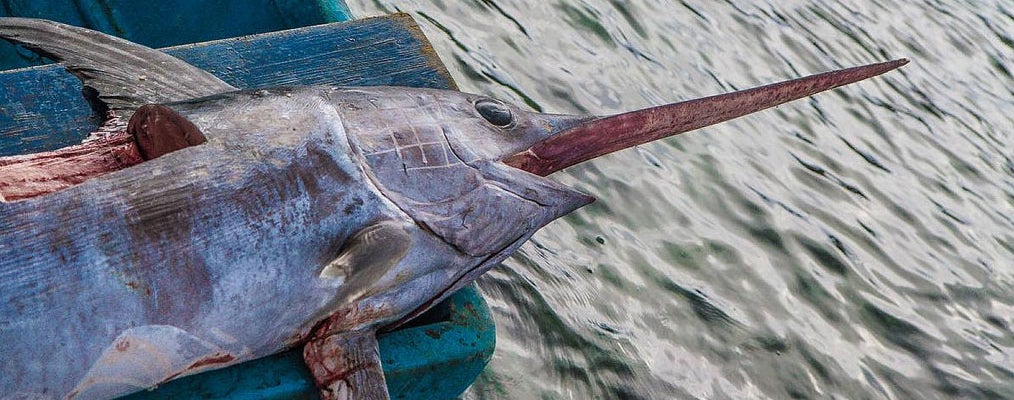Swordfish
The swordfish is an iconic, fast-swimming and peculiar predator of the Mediterranean Sea.
Its fishery (a place for raising and harvesting fish) contributes significantly to the socio-economic activity in the Mediterranean region-especially in Greece, Italy and Spain-where swordfish is consumed the most.
When sold fresh, its price tag can reach up to €24 per kilo.
However, the number of a Mediterranean swordfish has plummeted to critical levels. More than 3 decades of overfishing swordfish in this area has left stocks at only 30% in 2016, with no sign of a recovery.
Many swordfish caught in these waters are too young (juvenile, in fishing terms) to be able to reproduce, putting the long-term sustainability of swordfish at great risk.
Oceana calls on the EU and all Mediterranean countries sharing these waters to table a robust and immediate recovery plan to rebuild the region’s swordfish stocks. This recovery plan must be science-based and be presented at the ICCAT Commission (the international body charged with protecting swordfish) meeting in November 2016, which will determine the amount of swordfish that can be caught in the region (total allowable catches, (TACS)), and so ensure swordfish stocks gets onto the right path towards sustainable levels.
Infographic: How the EU is depleting Mediterranean swordfish
- What are they like?
Mediterranean swordfish (also referred to as SWO MED) are fast swimmers and often travel long distances in pursuit of prey. Unlike other fish of its size, Mediterranean swordfish behave differently; they travel alone, or together with their mate, and not in schools (groups of fish). In fact, some fishermen try to catch a female swordfish knowing that a male is not too far behind her.
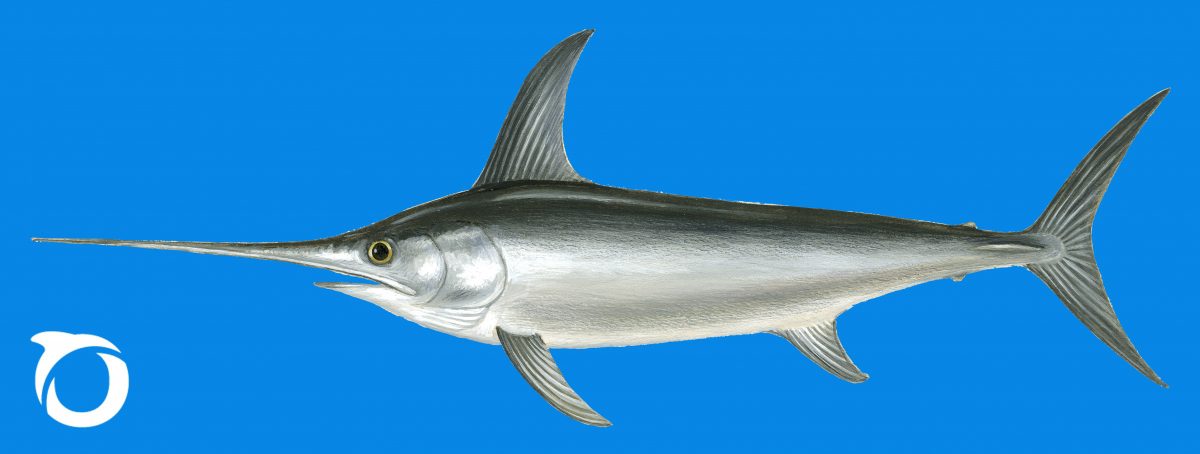
- How are SWO MED caught?
They are caught in several ways. Some more selectively like (targeting one species and thus not catching other unwanted fish) using a spear-like arrow (harpoon) that is ‘fired’ at the swordfish, but the majority are caught by means of large fishing boats called long liners that are equipped with hooks.
For many years, and particular during the 1980s and mid-1990s, the worst way to fish swordfish, or any fish for that matter, was through driftnets. Since 2007, these huge nets have been banned from use in EU Mediterranean waters for highly migratory species like tuna and swordfish. Then in 2009, ICCAT brought in a complete ban came into force for all Mediterranean waters.
- Why are stocks at a critical level in 2016?
Two factors: thirty years of relentless overfishing swordfish in the Mediterranean Sea has wiped out 70% of stocks, and a chronic lack of a management to fish swordfish sustainably and replenish this highly-commercial species.
Three quarters of the swordfish that end up at habour are too young and too small to reproduce. This is because the current minimum legal catch size for fisherman to legally catch SWO MED is set too low-at 90cm-meaning a biological recovery in swordfish numbers in the Mediterranean is near impossible. This is around 50cm smaller (adult maturity size) than the size recommended by scientists.
- How can we put this right?
Oceana recommends a series recovery plan that must be agreed and adopted at the ICCAT Special Meeting in November 2016. There, members of ICCAT will assess swordfish stocks and agree on the total amount of swordfish that can be fished for the next two years, also known in the fishing industry as total allowable catches (TACs).
At the 2016 ICCAT meeting, Oceana will campaign for a recovery plan to include:
- Stronger monitoring control and surveillance measures to combat overfishing in the region
- Protecting young, small swordfish (juveniles) by increasing the current catch size limit
- Stopping swordfish fishing in certain times of the year (Sept.-Dec.) to allow the juveniles time to reproduce
- Protecting vulnerable species that get caught in the process of swordfish fishing
For more detailed technical recommendations please check out our 2016 Position Paper: Inaction Is not An Option
|
Show your support for this important campaign by tweeting our plea for the Mediterranean swordfish! |
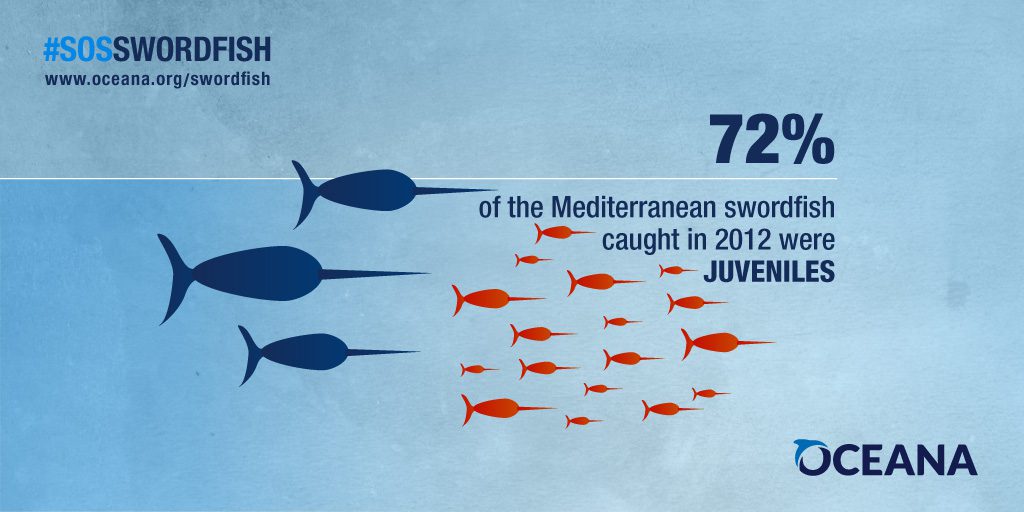 |
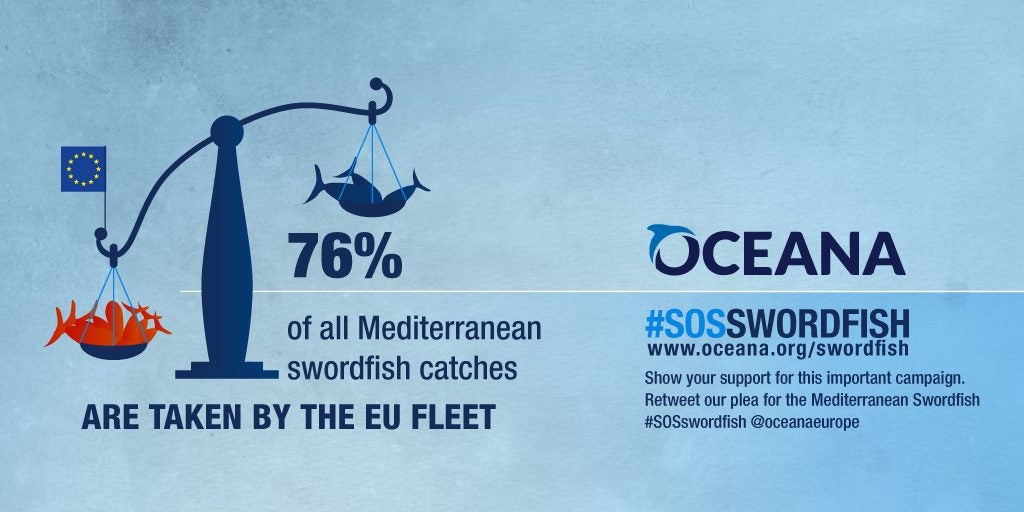 |
|
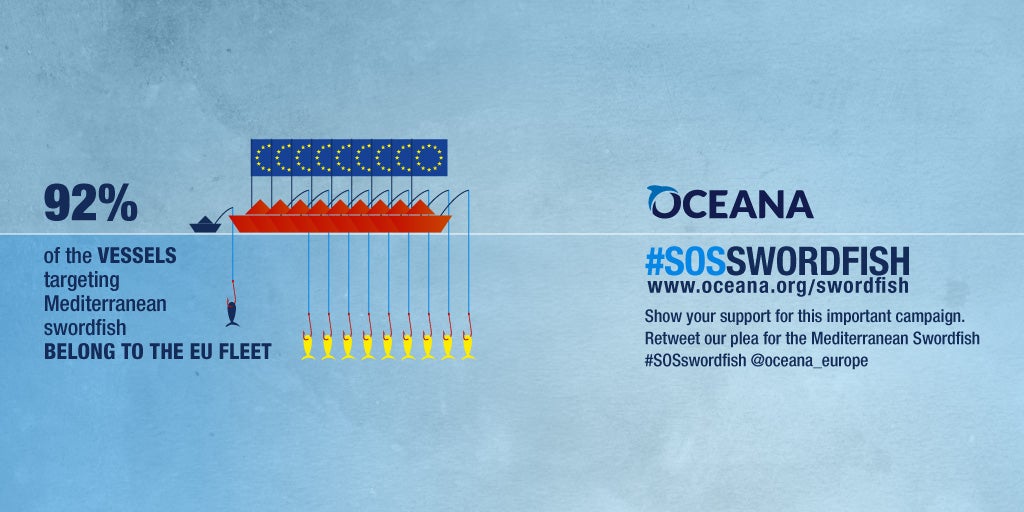 |
 |
|
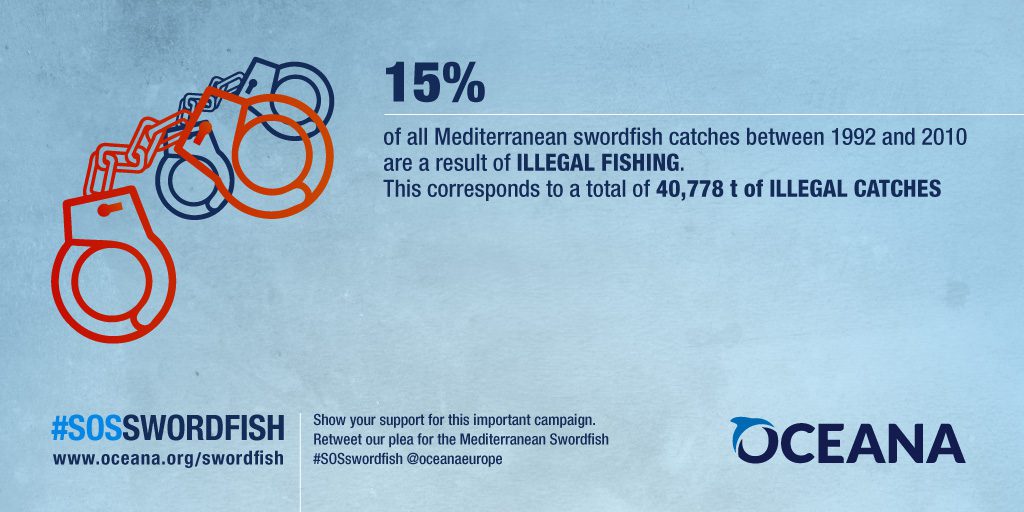 |
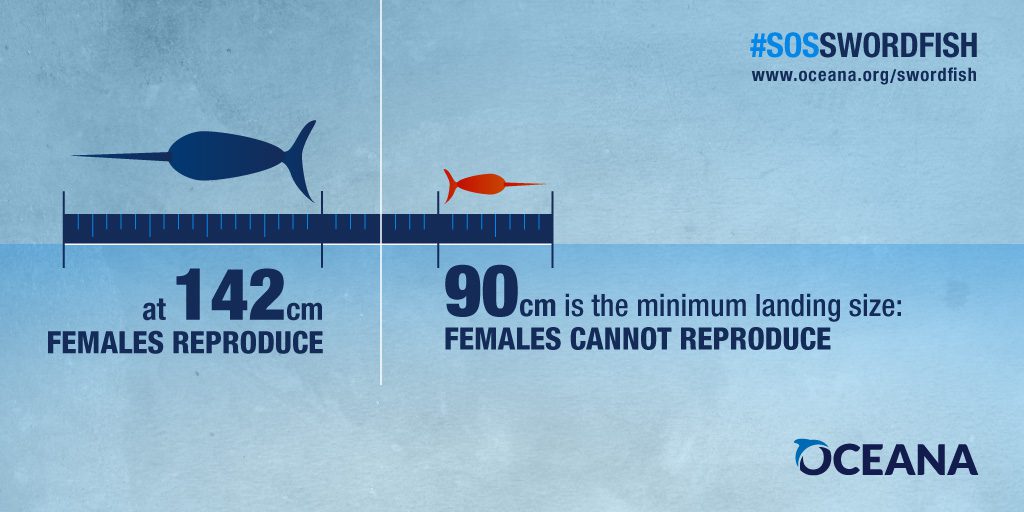 |
|
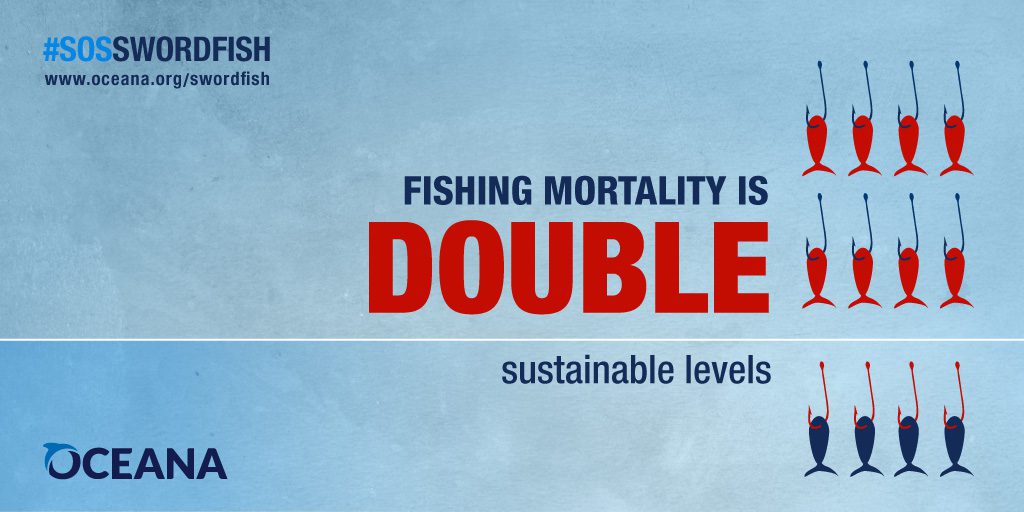 |
 |
|
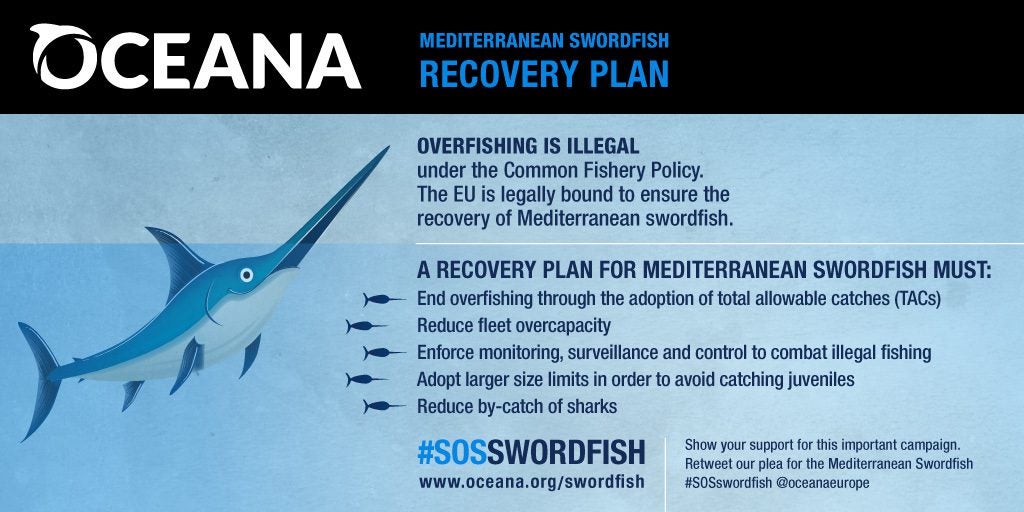 |
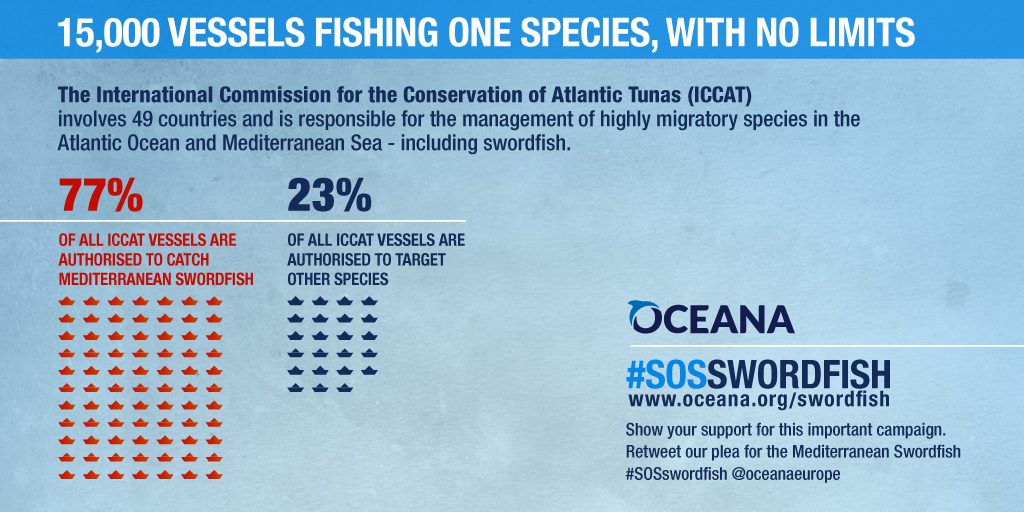 |
|
Video of Feluche. Artisanal fishermen as watchmen for the Mediterranean swordfish
Read our fact sheet on Mediterranean swordfish and our campaign for a recovery plan.
Inaction is not an option (ICCAT 2015) / Give swordfish a future (ICCAT 2014)
Press releases on swordfish
2016
Action not words for future of Mediterranean swordfish
New Italian vessel list is not enough to recover heavily overfished Mediterranean swordfish
2016 Position Paper: Inaction Is Not An Option.
Previous years
Oceana requests ICCAT to sail beyond Bluefin tuna and take care of swordfish and sharks
Oceana estimates illegal swordfish landings cost Italy more than €25 million every year
Oceana alerts that EU is turning blind eye to swordfish overfishing
Oceana says EU should act against true ‘walls of death’
Oceana urges zero tolerance for driftnets in the Mediterranean in 2011
Italian government keeps challenging EU driftnet ban
Oceana reports that Italy has ignored the European Union and has reintroduced illegal driftnets
Oceana ICCAT kills conservation os sharks and swordfish; keeps bluefin tuna alive
Oceana reveals European Commission documents proving illegal fishing of Mediterranean swordfish
A plea for Mediterranean swordfish
Oceana exposes illegal driftnet fisheries while Italy denies it
Oceana reveals illegal drifnet fishing in Morocco
Oceana Applauds ICCAT desision to protect vulnerable silky sharks
Oceana seeks protection for sharks and swordfish at ICCAT meeting in Turkey
Oceana urges EU to make strong lead at ICCAT to ensure the future of endangered species
Oceana calls for a definitive end of italian driftnets
Overfishing, pollution and habitat destruction are threatening European Seas
Oceana calls for swordfish management before it is too late
Oceana calls for immediate protection of large pelagic fish in the Atlantic and Mediterranean
Morocco promotes the plan to eliminate driftnets from their fleet
Hundreds of tons of swordfish caught illegally by Morocco are sold in Spain
Blogs
At the premiere of Sea Legend: United against the decline of the great fish
It’s time to protect Mediterranean swordfish
Reports
2008
Adrift! Swordfish and driftnets in the Mediterranean Sea
2010
Mediterranean Swordfish. The prevalent lack of management in Mediterranean ICCAT fisheries
2011
Oceana recommendations for a sustainable management framework for Mediterranean swordfish
Oceana Recommendations for an effective management framework for Mediterranean swordfish under ICCAT
Oceana recommendations for a sustainable management framework for mediterranean swordfish
2014


